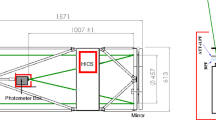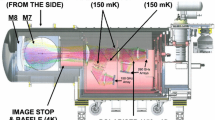Abstract
This study presents a general outline of the Qitai radio telescope (QTT) project. Qitai, the site of the telescope, is a county of Xinjiang Uygur Autonomous Region of China, located in the east Tianshan Mountains at an elevation of about 1800 m. The QTT is a fully steerable, Gregorian-type telescope with a standard parabolic main reflector of 110 m diameter. The QTT has adopted an umbrella support, homology-symmetric lightweight design. The main reflector is active so that the deformation caused by gravity can be corrected. The structural design aims to ultimately allow high-sensitivity observations from 150 MHz up to 115 GHz. To satisfy the requirements for early scientific goals, the QTT will be equipped with ultra-wideband receivers and large field-of-view multi-beam receivers. A multi-function signal-processing system based on RFSoC and GPU processor chips will be developed. These will enable the QTT to operate in pulsar, spectral line, continuum and Very Long Baseline Interferometer (VLBI) observing modes. Electromagnetic compatibility (EMC) and radio frequency interference (RFI) control techniques are adopted throughout the system design. The QTT will form a world-class observational platform for the detection of low-frequency (nanoHertz) gravitational waves through pulsar timing array (PTA) techniques, pulsar surveys, the discovery of binary black-hole systems, and exploring dark matter and the origin of life in the universe. The QTT will also play an important role in improving the Chinese and international VLBI networks, allowing high-sensitivity and high-resolution observations of the nuclei of distant galaxies and gravitational lensing systems. Deep astrometric observations will also contribute to improving the accuracy of the celestial reference frame. Potentially, the QTT will be able to support future space activities such as planetary exploration in the solar system and to contribute to the search for extraterrestrial intelligence.
Similar content being viewed by others
References
J.-Q. Cheng, The Principles of Astronomical Telescope Design (Springer, Heidelberg, 2009), p. 377.
S. Srikanth, R. Norrod, L. King, D. Parker, in IEEE Antennas and Propagation Society International Symposium (IEEE, Orlando, 1999), pp. 1548–1551.
R. Nan, D. I. Li, C. Jin, Q. Wang, L. Zhu, W. Zhu, H. Zhang, Y. Yue, and L. Qian, Int. J. Mod. Phys. D 20, 989 (2011).
M. Naddaf, Nature 613, 11 (2023).
G. B. Hobbs, M. Bailes, N. D. R. Bhat, S. Burke-Spolaor, D. J. Champion, W. Coles, A. Hotan, F. Jenet, L. Kedziora-Chudczer, J. Khoo, K. J. Lee, A. Lommen, R. N. Manchester, J. Reynolds, J. Sarkissian, W. van Straten, S. To, J. P. W. Verbiest, D. Yardley, and X. P. You, Publ. Astron. Soc. Aust. 26, 103 (2009).
R. M. Shannon, V. Ravi, W. A. Coles, G. Hobbs, M. J. Keith, R. N. Manchester, J. S. B. Wyithe, M. Bailes, N. D. R. Bhat, S. Burke-Spolaor, J. Khoo, Y. Levin, S. Osłowski, J. M. Sarkissian, W. van Straten, J. P. W. Verbiest, and J. B. Wang, Science 342, 334 (2013).
J. T. Xie, J. B. Wang, N. Wang, and Y. Hu, Res. Astron. Astrophys. 22, 075009 (2022).
D. R. Lorimer, Living Rev. Relativ. 11, 5 (2008).
N. J. Evans, Annu. Rev. Astron. Astrophys. 37, 311 (1999).
E. Herbst, and E. F. van Dishoeck, Annu. Rev. Astron. Astrophys. 47, 427 (2009).
J. Vink, Astron. Astrophys. Rev. 20, 49 (2012).
R. G. Bower, S. L. Morris, R. Bacon, R. J. Wilman, M. Sullivan, S. Chapman, R. L. Davies, P. T. de Zeeuw, and E. Emsellem, Mon. Not. R. Astron. Soc. 351, 63 (2004).
R. Blandford, D. Meier, and A. Readhead, Annu. Rev. Astron. Astrophys. 57, 467 (2019).
L. V. E. Koopmans, Mon. Not. R. Astron. Soc. 363, 1136 (2005).
F. Stoehr, S. D. M. White, V. Springel, G. Tormen, and N. Yoshida, Mon. Not. R. Astron. Soc. 345, 1313 (2003).
G. Bertone, N. Bozorgnia, J. S. Kim, S. Liem, C. McCabe, S. Otten, and R. R. de Austri, J. Cosmol. Astropart. Phys. 2018(3), 026 (2018).
P. Charlot, C. S. Jacobs, D. Gordon, S. Lambert, A. de Witt, J. Böhm, A. L. Fey, R. Heinkelmann, E. Skurikhina, O. Titov, E. F. Arias, S. Bolotin, G. Bourda, C. Ma, Z. Malkin, A. Nothnagel, D. Mayer, D. S. MacMillan, T. Nilsson, and R. Gaume, Astron. Astrophys. 644, A159 (2020).
M. S. Li, R. Li, N. Wang, and X. W. Zheng, Res. Astron. Astrophys. 20, 200 (2020).
P. Ries, Winds and Their Effect on the GBT, Green Bank Telescope (GBT) Precision Telescope Control System (PTCS) Memo 68, (National Radio Astronomy Observatory, Charlottesville, 2010).
S. Kendrew, L. Jolissaint, B. Brandl, R. Lenzen, E. Pantin, A. Glasse, J. Blommaert, L. Venema, R. Siebenmorgen, and F. Molster, SPIE, 7735, 201 (2010).
R. Wielebinski, N. Junkes, and B. H. Grahl, J. Astron. Hist. Herit. 14, 3 (2011).
M. Süss, D. Koch, and H. Paluszek, in Proceedings of the SPIE International Symposium on Astronomical Telescopes + Instrumentation, Amsterdam, 1–6 July 2012, edited by L. M. Stepp, R. Gilmozzi, and H. J. Hall (SPIE, New York, 2012), pp. 84442G1–84442G16.
K. Igor, A. Yuryb, and T. Aleksandr, in Fifth International Symposium on Instrumentation Science and Technology, edited by J. Tan, and X. Wen (SPIE, New York, 2008), p. 71333R–1.
R. Li, X. Qin, I. Konyakhin, M. H. Tong, A. Usik, Y. Lu, K. Di, and Y. Liu, IEEE Access 8, 51821 (2020).
E. White, F. D. Ghigo, R. M. Prestage, D. T. Frayer, R. J. Maddalena, P. T. Wallace, J. J. Brandt, D. Egan, J. D. Nelson, and J. Ray, Astron. Astrophys. 659, A113 (2022).
G. Kazezkhan, B. Xiang, N. Wang, and A. Yusup, Adv. Mech. Eng. 12, 1 (2020).
W. Gawronski, IEEE Trans. Contr. Syst. Technol. 15, 276 (2007).
T. Ranka, M. Garcia-Sanz, A. Symmes, J. M. Ford, and T. Weadon, J. Astron. Telesc. Instrum. Syst. 2, 014001 (2016).
J. Han, IEEE Trans. Ind. Electron. 56, 900 (2009).
G.-Q. Huang, C. Wen, J.-Y. Lu, and W.-Z. Su, Radio Eng. 52, 864 (2022).
M. Garciasanz, Robust Control Engineering: Practical QFT Solutions (CRC Press, Boca Raton, 2017), pp. 365–394.
M. Morgan, and J. Fisher, arXiv: 0908.3849.
A. Dunning, M. Bowen, M. Bourne, D. Hayman, and S. L. Smith, in Proceeding of 2015 IEEE-APS Topical Conference on Antennas and Propagation in Wireless Communications (APWC) (IEEE, Turin, 2015), pp. 787–790.
J. Tuthill, T. Bateman, G. Hampson, J. D. Bunton, A. J. Brown, D. George, and M. Baquiran, in Proceeding of PAF2016 Phased Array Feed Workshop (Italian National Institute for Astrophysics, Cagliari, 2016).
J. Kocz, L. J. Greenhill, B. R. Barsdell, G. Bernardi, A. Jameson, M. A. Clark, J. Craig, D. Price, G. B. Taylor, F. Schinzel, and D. Werthimer, J. Astron. Instrum. 03, 1450002 (2014).
X. Pei, N. Wang, D. Werthimer, X. F. Duan, J. Li, T. Ergesh, Q. Liu, and M. H. Cai, Res. Astron. Astrophys. 22, 045016 (2022).
X. Pei, J. Li, N. Wang, T. Ergesh, X. F. Duan, J. Ma, and M. Z. Chen, Res. Astron. Astrophys. 21, 248 (2021).
J. M. Ford, in GBT Telescope and Instrumentation Control System Hardware Architecture: Computers, Networks, Interfaces, and Timing, editor by H. Lewis (SPIE, New York, 1998), pp. 387–395.
Z. Y. Liu, J. Li, N. Wang, Y. Yuan, and M. Z. Chen, Sci. Sin.-Phys. Mech. Astron. 49, 099509 (2019).
Q. Liu, N. Wang, Y. Liu, and M. Z. Chen, Sci. Sin.-Phys. Mech. Astron. 49, 099511 (2019).
Q. Liu, Y. Liu, M.-Z. Chen, X.-M. Su, F. Liu, N. Wang, Y. Zhang, M. Zhang, and S.-P. Zhang, in 2019 RFI Workshop-Coexisting with Radio Frequency Interference (RFI) (Toulouse, RFI, 2019), pp.1–4.
A. Wootten, and A. R. Thompson, Proc. IEEE 97, 1463 (2009).
M. Cruces, D. J. Champion, D. Li, M. Kramer, W. W. Zhu, P. Wang, A. D. Cameron, Y. T. Chen, G. Hobbs, P. C. C. Freire, E. Graikou, M. Krco, Z. J. Liu, C. C. Miao, J. Niu, Z. C. Pan, L. Qian, M. Y. Xue, X. Y. Xie, S. P. You, X. H. Yu, M. Yuan, Y. L. Yue, Y. Zhu, K. Lackeos, N. Porayko, J. Wongphecauxon, and R. Main, Mon. Not. R. Astron. Soc. 508, 300 (2021).
J.-L. Han, C. Wang, P.-F. Wang, T. Wang, D.-J. Zhou, J.-H. Sun, Y. Yan, W.-Q. Su, W.-C. Jing, X. Chen, X.-Y. Gao, L.-G. Hou, J. Xu, K.-J. Lee, N. Wang, P. Jiang, R.-X. Xu, J. Yan, H.-Q. Gan, X. Guan, W.-J. Huang, J.-C. Jiang, H. Li, Y.-P. Men, C. Sun, B.-J. Wang, H.-G. Wang, S.-Q. Wang, J.-T. Xie, H. Xu, R. Yao, X.-P. You, D.-J. Yu, J.-P. Yuan, R. Yuen, R. C.-F. Zhang, and Y. Zhu, Res. Astron. Astrophys. 21, 107 (2021).
X. H. Cui, C. M. Zhang, S. Q. Wang, J. W. Zhang, D. Li, B. Peng, W. W. Zhu, N. Wang, R. Strom, C. Q. Ye, D. H. Wang, and Y. Y. Yang, Mon. Not. R. Astron. Soc. 500, 3275 (2021).
G. Hobbs, S. Dai, R. N. Manchester, R. M. Shannon, M. Kerrl, K.-J. Lee, and R.-X. Xu, Res. Astron. Astrophys. 19, 37 (2019).
Author information
Authors and Affiliations
Corresponding author
Additional information
This work was supported by the National Key Research and Development Program of China (Grant Nos. 2021YFC2203501, 2021YFC2203502, 2021YFC2203503, and 2021YFC2203600), the National Natural Science Foundation of China (Grant Nos. 12173077, 11873082, 11803080, and 12003062), the Scientific Instrument Developing Project of the Chinese Academy of Sciences (Grant No. PTYQ2022YZZD01), the Operation, Maintenance and Upgrading Fund for Astronomical Telescopes and Facility Instruments, budgeted from the Ministry of Finance of China and Administrated by the Chinese Academy of Sciences, and the Chinese Academy of Sciences “Light of West China” Program (Grant No. 2021-XBQNXZ-030).
Rights and permissions
About this article
Cite this article
Wang, N., Xu, Q., Ma, J. et al. The Qitai radio telescope. Sci. China Phys. Mech. Astron. 66, 289512 (2023). https://doi.org/10.1007/s11433-023-2131-1
Received:
Accepted:
Published:
DOI: https://doi.org/10.1007/s11433-023-2131-1




